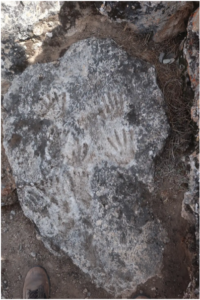Earliest Prehistoric Art in The World discovered in Tibet

DHARAMSALA, 16 Sept: The oldest-known work of art — a series of hand and foot impressions have been discovered in Tibet.
“Five handprints and five footprints that appear to have been intentionally placed on the surface of a unit of soft travertine- a type of limestone- which dates back to 169,000 and 226,000 BC is the earliest currently known example of parietal art in the world” an international team of researchers led by David Zhang from China’s Guangzhou University who made the remarkable discovery in 2018 on a rocky outcrop in Quesang, on the Tibetan Plateau have said.

The prints discovered at 2,000 feet above sea level “was deposited by water from a hot spring which is now inactive and as the travertine lithified it preserved the traces,” the researchers have said.
“This would make the site the earliest currently known example of parietal art in the world and would also provide the earliest evidence discovered to date for hominins on the High Tibetan Plateau (above 4000 m a.s.l.),” the team added.
It is reported to be at least 3–4 times older than the cave paintings of France, Indonesia and Spain.
The researchers have added that the “discovery adds to the body of research that identifies children as some of the earliest artists within the genus Homo.”
Parietal art is a form of ancient visual expression that typically crops up on cave walls, however, the latest discovery in Tibet was found on the ground.
In 2018, a stone tool workshop unearthed in Tibet by the Chinese archaeologists suggested that the earliest evidence of humans on the roof of the world dates back to 30,000 – 40,000 years ago.






